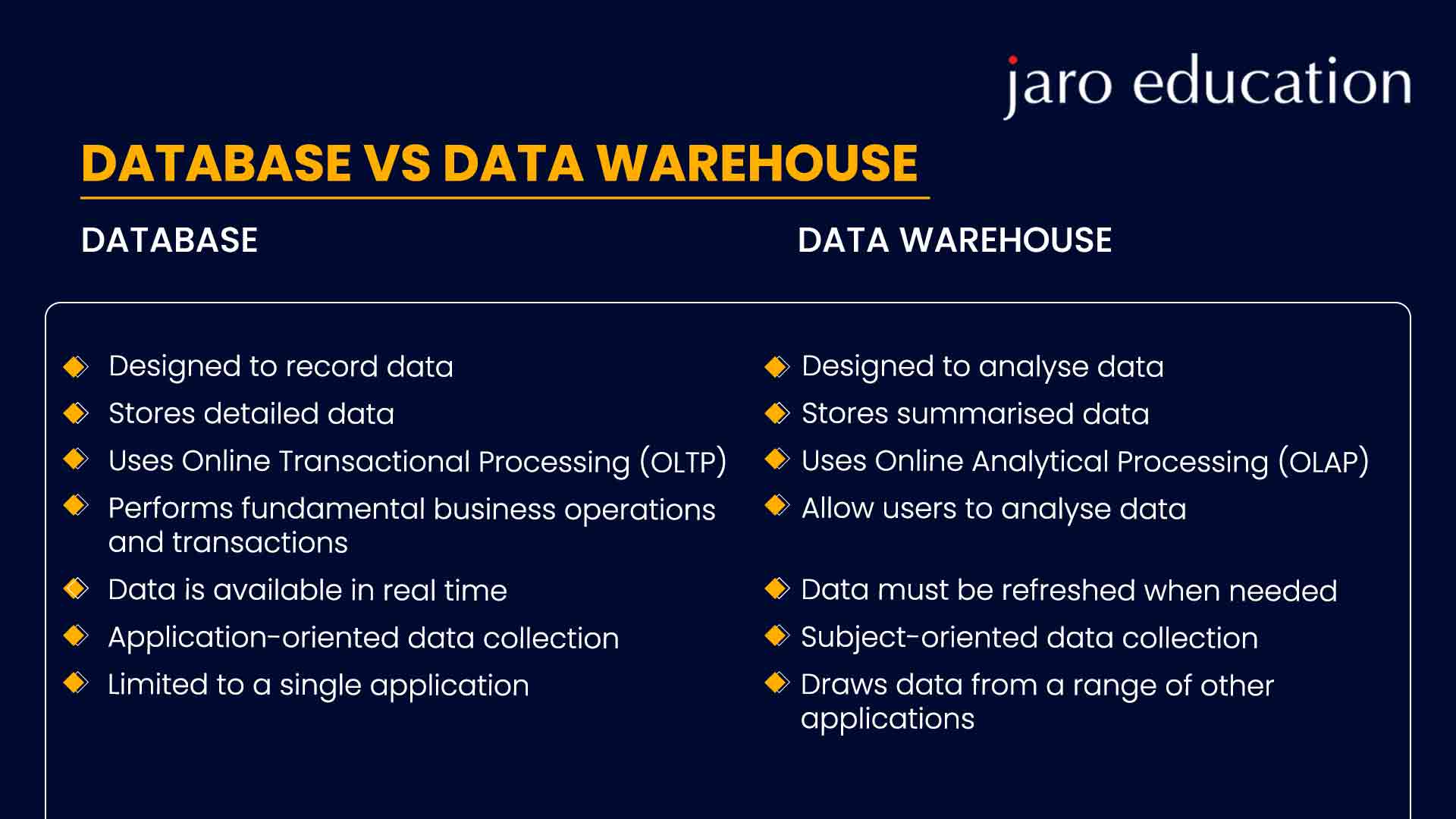
What Is a Data Warehouse?
Data warehousing plays an important role in the ecosystem, serving as a fundamental component of business intelligence that empowers businesses to enhance their decision-making processes. In a data warehouse, information is securely stored electronically by a company or other organisation. Creating a treasure trove of historical data that can be accessed and analysed to offer helpful insight into the organisation’s activities is the aim of a data warehouse.
To delve deeper into the world of data warehousing and understanding integral concepts of data warehouse, let’s move further.
How Data Warehouse Works?
As companies started depending on computers to create, store, and retrieve crucial business papers, the need for warehouse data emerged. Data warehousing was first proposed by IBM engineers Barry Devlin and Paul Murphy in 1988.
The goal of data warehousing is to make it possible to analyse historical data. Comparing data that has been combined from many heterogeneous sources might give information about a company’s performance. Users of a data warehouse can perform queries and analytics on historical data acquired from transactional sources.
However, data added to the warehouse is static and unchangeable. Thus, the warehouse serves as the data source for historical analytics with an emphasis on changes over time.
Key Features of Data Warehouse
The important features of Data Warehouse are as follows:
Centralised Data Repository
Table of Contents
Data warehousing serves as a central repository for enterprise data, drawing from various sources like transactional databases, operational systems, and external resources. This consolidation empowers organisations with a holistic perspective of their data, facilitating well-informed decision-making.
Integration of Data
It smoothly integrates data from diverse origins into a unified view. This integration eradicates data silos and minimises inconsistencies, promoting data harmony and coherence.
Historical Storage of Data
A key function of data warehousing is preserving historical data. This historical archive helps organisations conduct trend analyses over time, enabling the identification of patterns and anomalies that can be leveraged to enhance business performance.
Analysis and Query
Strong query and analysis tools are provided by data warehousing, allowing users to explore and examine data in a variety of ways. This helps to identify trends and patterns, which form the basis for wise business decisions.
Transformation of Data
To ensure consistency and usefulness, data from various sources must be cleaned, filtered, and formatted as part of the data warehousing process. This strengthens the data’s integrity by improving data quality and reducing discrepancies.
Data mining
Data warehousing gives enterprises the ability to mine their data for hidden patterns and connections. This discovery approach can be helpful in spotting new opportunities, forecasting trends, and better managing risks.
Access restrictions
Data encryption and data backup systems are just a few of the data security components that make up data warehousing. With the help of these security measures, data is kept secure and resistant to unauthorised access, preserving its integrity and confidentiality.
Data Warehouse Architecture
Data warehouse architecture typically follows a three-tier structure, each serving a distinct purpose:
Bottom Tier
This tier represents the data warehouse server, which is usually implemented as a relational database system. Back-end tools are used to cleanse, transform, and load data into this layer.
Middle Tier
The middle tier hosts the OLAP (Online Analytical Processing) server, which can be implemented in two ways: ROLAP (Relational OLAP) and MOLAP (Multidimensional OLAP). ROLAP extends the capabilities of a relational database management system to handle multidimensional data processing, while MOLAP directly operates on multidimensional data.
Top Tier
The top tier serves as the front-end client interface, providing access to the data stored in the data warehouse. It encompasses various tools, including query tools, analysis tools, reporting tools, and data mining tools, facilitating data retrieval and analysis.
Types of Data Warehouses
There are three primary types of data warehouses, each serving specific purposes:
Enterprise Data Warehouse (EDW)
An enterprise data warehouse functions as a central repository that supports decision-making throughout an entire organisation. It offers access to cross-organisational information, ensuring a uniform approach to data representation, and accommodates complex queries.
Operational Data Store (ODS)
Operational data stores refresh in real-time and are often used for routine tasks such as storing employee records. They become necessary when data warehouse systems do not meet the reporting needs of the business.
Data Mart
A data mart is a subset of a data warehouse created to cater to the needs of a particular department, region, or business unit. Each department typically has its own data mart, and the data from these marts is periodically transferred to the enterprise data warehouse for storage and further analysis.
Benefits of Data Warehouse
Businesses can reap numerous benefits from implementing data warehousing solutions. These advantages include:
Improved Data Consistency
Data warehouses ensure that data remains consistent and reliable, providing a solid foundation for decision-making.
Better Business Decisions
Access to historical and integrated data enables organisations to make more informed and data-driven decisions.
Easier Access to Enterprise Data
Data warehouses provide a single source of truth, simplifying access to critical data for end-users.
Better Documentation of Data
Data warehousing systems document data comprehensively, enhancing data traceability and reliability.
Reduced Computer Costs and Higher Productivity
By offloading analytical queries to the data warehouse, operational systems can focus on transactional processes, resulting in lower costs and improved productivity.
Ad-Hoc Queries and Reports
End-users can create ad-hoc queries and reports without impacting the performance of operational systems, with the help of a data warehouse.
Consolidation of Data
Data warehouses collect and consolidate related data from various sources, making it easier for organisations to analyse data holistically.
Companies with dedicated data warehouse teams gain a competitive edge in areas such as product development, pricing strategies, marketing, production optimisation, historical analysis, forecasting, and customer satisfaction. While data warehousing may involve initial investments, the long-term benefits in terms of improved decision-making and operational efficiency make it a valuable asset for any organisation.
Applications of Data Warehouse
Data warehousing finds applications in various industries, impacting decision-making and operations in significant ways. Here are a few examples of how different sectors leverage data warehousing:
Financial Services
Investment and insurance companies rely on data warehouses to analyse customer and market trends, helping them make informed decisions in rapidly changing markets.
Retail
Retail chains use data warehouses for marketing, distribution, and inventory management. They utilise data warehouse models for business intelligence, enabling them to track items, examine pricing policies, and analyse customer buying trends.
Healthcare
Healthcare organisations employ data warehouse concepts to generate treatment reports, share data with insurance companies, and support research and medical units, as access to the latest treatment information is crucial for saving lives and ensuring the highest quality of care.
Data Warehousing:Tools
Data warehousing tools are software components used to perform various operations on extensive datasets. These tools are designed to collect, read, write, and transfer data from diverse sources and provide support to operations such as data sorting, filtering, merging, and more. Some popular data warehouse tools include Xplenty, Amazon Redshift, Teradata, Oracle 12c, Informatica, IBM Infosphere, Cloudera, and Panoply.
Advantages of Data Warehousing
Data Quality Improvement
Data warehousing improves data quality by centralising information from various sources into a consistent and unified format. This consolidation mitigates inconsistencies and errors, resulting in cleaner, more reliable data.
Faster Access to Information
It facilitates swift access to critical information, enabling businesses to make quicker and more informed decisions, as real-time data retrieval and analysis expedite decision-making processes.
Improved Decision-Making
With a data warehouse, businesses gain the ability to analyse data comprehensively, uncovering valuable insights into trends and patterns. This empowers more informed, data-driven decision-making that can positively impact business outcomes.
Reduced Data Redundancy
It helps to ease the process of consolidating data from diverse sources, leading to reduced data redundancy and a decrease in data inconsistencies. This streamlining enhances data accuracy and reliability.
Scalability
Data warehousing solutions are highly scalable and capable of efficiently handling vast volumes of data from various sources, making them adaptable to evolving business needs.
Disadvantages of Data Warehousing
Cost
Establishing a data warehouse can be a costly endeavour, necessitating substantial investments in hardware, software, and skilled personnel. This financial commitment can be a barrier for some businesses.
Complexity
Data warehousing systems can be intricate, requiring businesses to employ specialised personnel with expertise in managing and maintaining the system. This complexity can be a challenge for some organisations.
Time-Consuming
The process of building a data warehouse demands a significant amount of time and dedication. Businesses need to be patient and committed to the process, which may take considerable time to yield the desired results.
Challenges in Data Integration
Integrating data from different sources can be a complex and time-consuming task. Ensuring data consistency and accuracy requires significant effort and meticulous planning to overcome integration challenges.
Data Security
Data warehousing introduces data security risks. Businesses must implement robust measures to safeguard sensitive data from unauthorised access or breaches. The security of data is of paramount importance and requires ongoing attention to maintain data integrity and confidentiality.
Database vs. Data Warehouse
While databases and data warehouses share some similarities, they are distinct in their primary functions and purposes. Databases are mainly designed for multiple transactional purposes, offering real-time data processing capabilities. In contrast, data warehouses are optimised for extensive data storage and analysis, making them ideal for handling large-scale analytical queries.

*www.hevodata.com
Data warehouses are an example of OLAP (Online Analytical Processing) systems designed for complex data analysis and reporting. On the other hand, databases, particularly OLTP (Online Transaction Processing) systems, are focused on data modification and real-time transaction processing. The fundamental difference lies in the intended use and scale of data processing.
Conclusion
With subject-oriented, integrated, non-volatile, and time-variant characteristics, data warehouses are well-equipped to support analytical endeavours across various industries. Whether you are in finance, retail, healthcare, or any other sector, understanding the concepts and applications of data warehousing is essential for thriving in today’s data-rich environment. As data warehousing continues to evolve, its role in shaping the future of business intelligence remains pivotal.
To delve deeper into the concept of data warehousing, consider applying for Amity University’s Master of Science (Information Technology) program through Jaro Education. This program stands out for its extensive curriculum, involving data warehousing as a specialisation elective course, taught by international faculty with the help of live interactive lectures, discussion forums, etc. Enroll today!








